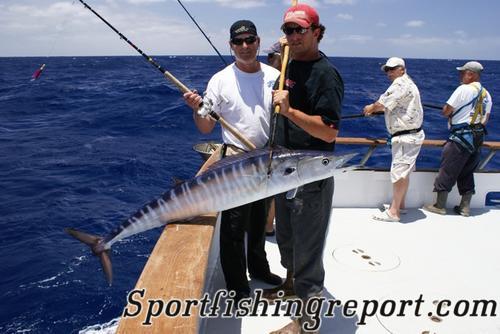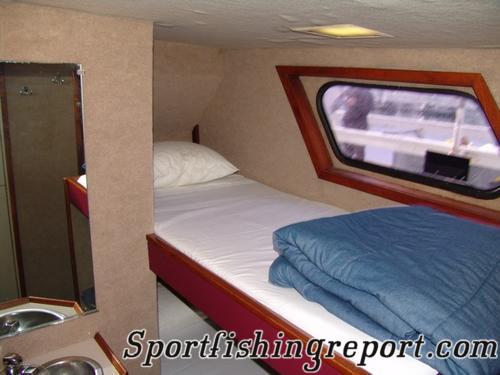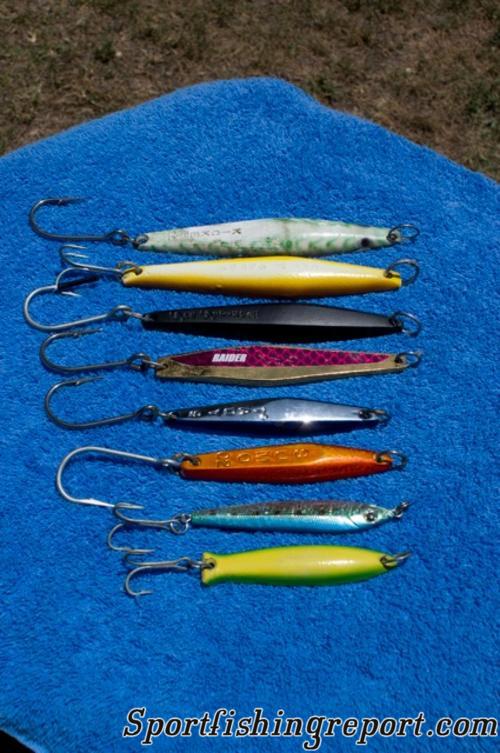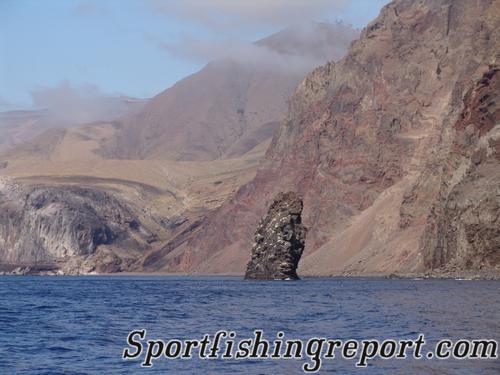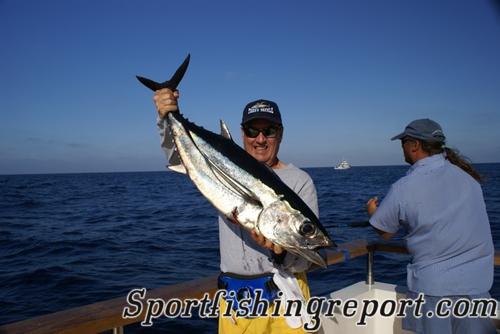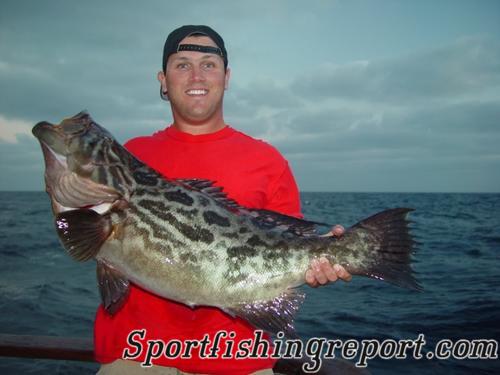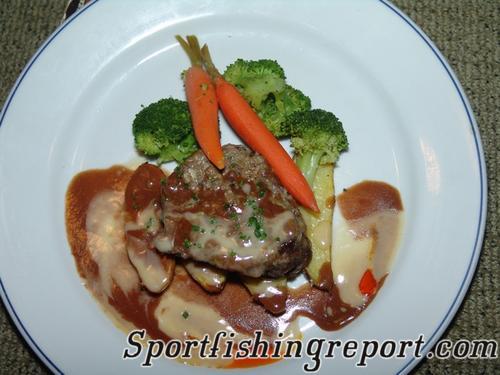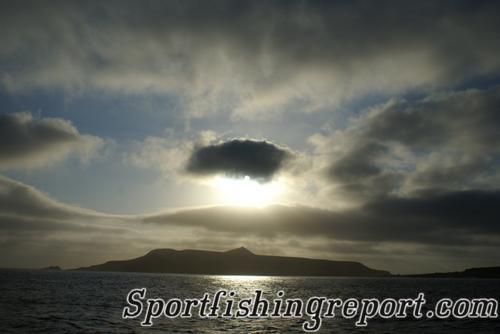Utah Fish Report
Fish Report for 5-11-2009
Fish Report for 5-11-2009
Long Range Fishing: The Mix Can Amaze Beginners
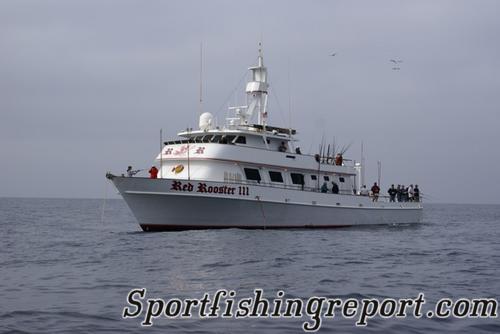
by Bill Roecker
5-11-2009
Website
Conditions Look Good
Here in the southland we're expecting albacore to make a showing in the next few weeks. If they behave as they have for the past several seasons, the longfin will show up a couple of hundred miles south of San Diego and work their way up toward town. It may be more weeks before they're available to overnight boats, or skiffs and cruisers coming from San Diego or Los Angeles.
Even more of a likelihood is a strong yellowtail bite in the San Benitos-Cedros Island area, and also in places both north and south of The Yellowtail Triangle. Guadalupe Island is another spot that produces big bad homeguard yellows. It's not unusual there to catch a daily limit of five yellowtail and find none are less than 30 pounds, with some over 40.
Fishing is expected to be good south of San Diego this summer and fall. If you haven't tried multi-day or long range fishing before, this year is the right time. Fuel costs are much less than they were last year, so trips may cost less. Fishing off Baja also gives you a chance at exotics not much seen up this way except in warm water years, or at the tail end of the local season. On a long ranger, you might get a shot at bigeye tuna, bluefin tuna, marlin, dorado or even wahoo.
Big Boats Best Bet
And that's just part of it. Newcomers will find that long range boats, at 80 to 125 feet, are stretch-out comfy, with lots of room aboard, big tables at the booths and big bunks in the staterooms. They have crewmen who serve delicious meals, answer fishing questions, and help you out of problems like bird-nested reels, fish hung on the anchor line or in the props, or tangles with other anglers. The service and the food here just can't be beat, whether you're fishing albacore, the beach or the islands.
Long range skippers know best how to find the fish. Yellowfin tuna from 20 to over 200 pounds are the primary target, the staple for fishing trips of five to 16 days or more.
"You've got to fish for what's biting," says veteran long ranger Jack Nilsen of Accurate. "The boats go south because that's where the fish are."
These adventures for tuna, wahoo, dorado and yellowtail are prime. Yellowtail fishing at Baja's islands may be wide open all year, on jigs or bait, on the surface or the bottom. Keeper yellows run from 10 to 50 pounds or more. Two world record yellows (91.6 and 92.1 pounds) were caught at Guadalupe Island in 2003 and 2004!
From June to December wahoo can go nuts at Alijos Rocks, The Ridge and offshore banks between Punta Eugenia (Baja's "elbow") and Cabo San Lucas.
Dorado may be common as sunny days when you go south of Eugenia, and yellowtail are thick until you get well below Magdalena Bay. Striped marlin can be thick on The Ridge. Wahoo may "wolf pack" around the edges of feeding groups of marlin. If bait (usually sardines) is concentrated, game fish will congregate on high spots and under floating weeds or debris as well. Other species encountered include cabrilla, grouper, snapper, rockfish, ling cod, amberjack and sometimes bluefin or bigeye tuna.
Departure Day
Long range boats leave around lunchtime, spanking clean, provisioned and refueled, after dropping off the last trip's anglers between six and eight a.m. Anglers need a picture ID to check in. Leaving San Diego harbor, boats pick up live bait from receivers where the sardines, anchovies and/or mackerel have been "hardened" for long range use by time and feeding in pens. Hundreds of scoops of prime baits go into large bait tanks on deck and into below-deck "slammers." Next, the skipper assembles the group in the galley to address passengers about safety, meals, drinks and the upcoming fishing.
Anglers room singly or in pairs, sleeping on two large bunks in private, carpeted staterooms with sinks, closets or drawers for storage and in some cases, flat screens with DVDs or satellite hookups. The boats have four to six bathrooms with showers and heads. Passenger loads vary from a dozen to 30-plus, and the boats are from 80 to 125 feet in length. Bring your own tackle, or rent or borrow it from the boat or landing, if you fly into San Diego. Lindbergh Field is just a mile from the docks. Your landing will arrange for a cab to pick you up. Each boat can advise you as to what expected needs are for any trip. Don't forget to bring sunblock!
Three meals per day are served at your table by crewmen. Snacks are offered at mid-morning and mid-afternoon, and fruit, candy and drinks are always ready. Meals range from good restaurant-type food to eye-popping dinner displays created by schooled chefs. Your ticket price includes everything but beer, pop, tips or any terminal tackle you get from the boat's store.
Long range galleys are huge, with booth seating and window views. Hundreds of gallons of fresh water are made daily by reverse osmosis. A crewman for every three or four anglers insures proper attention at the rail. The crew will have answers to any questions you might have about how to fish. Tackle, expert advice, a workshop, sat phones and first aid are available. Comfort and safety aboard are powerful reasons to fish long range.
Anglers with dietary needs (no red meat, or allergies, etc.) are cheerfully accommodated by long range chefs. Chicken or fresh fish are always available as a substitute for the planned meal. Whatever you're eating, it's likely to be tasty. Few anglers get off a long ranger weighing less than they did when they stepped aboard.
Where The Fish Are
These are some of the best spots, heading south: Guadalupe Island, Cedros, the Benitos and Natividad Islands and coastal nooks and crannies like Canoas, San Pablo, Turtle Bay and Magdalena Bay. Outside are Alijos Rocks, Alijos Banks, The Ridge, and southern banks like the Thetis, 50-50, Potato, Morgan, Toussaint, Luisitania, Finger, The Rabbit, Jaimie and the Golden Gate Bank. Expect some tackle loss while island fishing on anchor, as pinnacles and rugged bottom structure dominate. Skippers get more fishing time by moving between spots at night.
Drift fishing may be in open water thousands of feet deep or on shallows of a hundred feet. Some of the fishing may be at night, in an offshore breeze, and much of it is in near-tropical waters with a hard daytime sun, so come prepared with jacket and long pants as well as shorts and sun screen.
Bait Fishing
Sardines are the most common live bait, in use about 80 percent of the time. Mackerel and anchovies are also widely used, and so is squid, either live or frozen. Fresh or frozen flying fish are good kite baits.
"The best thing a guy can learn is why, when and where to hook your live bait," says Tommy Rothery, owner-skipper of the Polaris Supreme. "First, use the nose-hook method when you're anchored in current or drifting on the move. You can nose-hook baits with or without sinkers.
"Second, when casting isn't right for you or isn't possible because of the conditions, belly-hook the bait. Belly-hooked bait goes down, and is just right for fish that are staying down.
"It's important to learn how to fish the swing of the anchored boat. You make your cast at the end of the swing. When the boat starts to swing back, you cast out, the other way. That way you can get your bait out without tangling the other guys."
The thing to remember here is to present your live bait in the most natural way possible, from getting it out there unhurt and un-stunned with a lob cast to staying in contact with the bait via your fingertips. Fluorocarbon leaders and ringed circle hooks may help to get bit.
Casting: A Prime Factor
"Many anglers who don't fish on a regular basis don't use the rod properly," says Randy Toussaint, owner-skipper of the Royal Star. "They try to cast with body English. We use the full length of the rod with the pendulum cast. Time the cast so that when the bait is swinging away, you follow through with your cast. Let the bait hang down almost to the reel and use a swinging or pendulum motion to begin the cast, and let the bait come around through the arc of the cast. This is so the cast remains gentle and doesn't snap the bait off the hook.
"Avoid the line drive cast," admonishes Toussaint, whose initial nickname among long rangers was "Terminator," because we was often asked to finish off big tuna that had bested their anglers. "The reason to cast further is because you've got to get the bait out away from the boat, especially if the tuna are leery."
On Rods & Jigging
"I've seen a lot guys do well deep jigging yellowtail with a rod of six to seven feet," says Andy Cates, Red Rooster III skipper. "You can be successful on yellowtail by using the yoyo method, especially when you're when drifting over shallows.
"For yoyo jigging yellowtail I like blue and white color and ???scrambled eggs' in the 6X Jr. For deep jigging tuna I like chrome, chrome and blue jigs, and the glow in the dark Tady 45, or all-white jigs.
"You can use a longer rod of seven to nine feet with the surface iron. When the fish are up breezing and not biting close, you can reach ???em with the skip jig and the surface jig. We also had this experience at Clipperton Atoll, on bigger tuna. The reason for the rod length is it gets you a longer cast, and you get the action of the jig coming across the surface. Skip the jig for tuna, and wind it for the yellowtail, swimming the jig.
"A good skip or surface jig would be a Salas 7X or a Tady 45. The 7X is best for tuna; the 45 is best for yellowtail. When you cast either, when it hits the surface, put it in gear fast. The weight of a deep jig is about 4 ounces or more; the weight of a surface jig is about two or three ounces.
"Skipping the jig (cranking it across the surface at top speed) is the most exciting way to hook up. Sometimes an all-green jig is best for skipping the jig on tuna in the blue water. I like the anticipation of what's next: dorado under a log, maybe some wahoo, a spot of tuna under a bird, or a huge school of breezers?Ķit's a very fertile area."
Leader Eaters
I saw both wahoo strikes that came to me while fishing tuna aboard Independence with sardines, fluorocarbon leader and smallish 5/0 ringed Mustad circle hooks. The first ???hoo slashed the sardine in a slicing splash we all saw, and soon after hook set it zipped up the port side fast and inside, toward the bow. I got my rod and line over the anchor rope and the skinny came to gaff. Looking at my badly-nicked leader, I knew I was lucky.
My luck ran out when I saw another splash on my bait. I wound down to set the hook. The line tightened, and went slack. When I reeled in, all 27 yards of fluorocarbon leader were missing, including the knot, and six yards of mono showed nasty chomp marks. Old-timers say it's not uncommon for wahoo to swim right up your line, even eating wire leader that way. It's like feeding line into a shredder.
This fish swam away rather than toward me, however. Another angler suggested a second wahoo had blundered into the line, or bit the bait after it had been knocked up the line. It was a mysterious event. But catching the first one on a circle hook and fluorocarbon leader made a point for using that combination.
Trolling
Whenever there are wahoo around, skippers may spend some time each day trolling with 80-pound or heavier gear with wire leaders for the skinnies. They'll bite on skirted jigs and hard "plugs," like Marauders, and when a wahoo takes the trolled jig the boat stops as quickly as possible and other anglers toss out iron or baits. This can lead to a good little snap, if there are numerous wahoo nearby.
Tuna and yellowtail are also caught on the troll, on the same jigs or on smaller skirted jigs meant for albacore. Trolling is employed to find fish, however, not to make a catch on a long range boat. Only four or five anglers can troll at once, so the method is mostly used to locate schools of biters.
Kite Fishing
Kite fishing works like the proverbial sky hook, getting the bait out two or three hundred yards from the anchored boat. Several kite models accommodate varying wind strengths. The kite is controlled with a rod and reel, often with an automatic reeling device, like a small winch or hand drill. If the wind is too light, a helium balloon can be added to float the kite. The angler's line is suspended by a clip attached to the kite string. When a tuna or wahoo takes the bait, tension pops the angler's line away from the clip.
Kite fishing's strength and attraction is that fish can't see the leader, and often attack kite baits with great vigor, jumping out of the water to come down on the hanging squid, mackerel or flying fish. Two kites up at once is usually the maximum. On a fall trip to Alijos aboard Royal Star one day, five complete rotations were made on the kite; all anglers had five turns, and all got hookups on heavy gear.
The worst of kite fishing is that some days the tuna just don't want any. Six or eight hours of staring at a tiny spot out on the rolling water is a long time, especially if your buddies are catching ???em on the flyline. But if you want a big tuna, and you don't mind fishing with heavy tackle, you'll want to take your turn on the kite. Trolling around or between hot fishing spots is also done by turn. (Balloons can also be fished without kites, another method to get a hook bait out where the fish are boiling.)
Homecoming
Long range fish go into refrigerated salt water tanks at less than 30 degrees, which keeps them sushi-fresh. If they're to be kept for more than a week on the boat, they'll be frozen hard in a brine-spray hold.
On arrival morning fish are unloaded by the crew. Each angler gets his/her own fish back on the dock, marked by tags. If you don't want to cut your fish, several fish processors will be on hand to cut and wrap, or smoke or jerk the meat. You can have your fish shipped to any major airport, maybe even to your door, by arrangement. Mexican limits are generous, and a mixed catch of tuna, wahoo, dorado and yellowtail makes for prime eating.
There's a lot of exotic scenery out there, a lot of fish, and a good possibility to catch a personal best of many species. If you've never tried long ranging, you should. San Diego's fleet offers unusual comfort, safety, stateroom privacy, truly excellent food, and the best guides in the fishing business; the captains and crews of these big, beautiful boats.
Bill Roecker's Tackle Suggestions
Since there are so many trips to so many places no one list can cover all the possibilities. With that in mind, I'll keep the following list confined to outfits and basic tackle. New anglers should remember that the boats are prepared to supply some tackle aboard, mostly the terminal items like hooks, line, sinkers and basic jigs. The crews can often perform minor repairs as well.
Most boats have some loaner tackle that will work for heavy gear, such as kite rigs and trolling rigs, so newcomers don't have to bring these. If you want to bring your own, though, your heavy rig should be at least 80 pounds of rated strength, up to 130 pounds, with a matching two-speed reel and Spectra backing.
Also recommended are rod, reel and line combos of 60, 50, 40 and 30 pounds. A light rig of 15 to 25 pounds might also be handy for small fish, bait fishing or a shot at a world record.
The heavier, 50 and 60-pound outfits can be from five and a half to seven feet in rod length. A surface jigging rod of 40 or 50 pounds could be seven or eight feet long; some experts prefer one of nine or ten feet. Two-speed reels would be advisable for medium and heavy gear. If you don't put your rod on the rail when playing fish, a fighting belt and harness will save strain on your back, shoulders, arms and groin.
The lighter outfits should be the gear that best suits the preferences of the angler. Short rods are fine, but so are rods up to eight feet. Just remember the fish down the Baja are wild and tough. So don't "cheap out." Bring quality, name-brand gear. On the fishing grounds, tackle failure brings embarrassment and regret.
Bring fluorocarbon leader material with you, and a good supply of your favorite hooks in sizes 1/0 to 8/0. Circle hooks, J hooks and ringed hooks of both types are good. Bring a few bait makers, four-fly gangions or "Lucky Joes," as well.
Carry aboard your own jigs, the ones you have the most faith in, and also a few that have never caught a fish. If the fishing gets really hot, throw out one of those, because the fish may not care how it looks or even swims. When tuna, yellowtail, dorado or wahoo get frenzied, they'll literally bite anything they see in the water. Expect to lose some jigs, especially if you find the wahoo or fish near jagged, rocky bottoms.
If you plan to release fish, and you should, use jigs with a single rather than a treble hook. The fish will be released with greater ease and less trauma with single hooks.
You can also bring your own plastic baits, though toothy species like triggerfish and snappers may bite off the tails as fast as you can replace them. In warmer southern shallows, this can be a serious problem.
The Bottom Line
You can have fun and catch fish on a long range trip with a huge, loaded tackle box or with a small bag of tackle. I always bring about eight rod/reel combos, but I often end up fishing with only two or three of them. Every trip is different.
This summer offers some outstanding fishing possibilities for fish far larger and more numerous than can be counted on locally. Fuel prices are low, way down from where they were while the economy went south. Some trips, maybe most of them, will sell at reduced prices from last year. If you've never tried multi-day or long range fishing, now's the time. What are you waiting for? Get on a boat and go fishing.
Here's The Fleet
Each of San Diego's regular long range boats listed is alphabetically, along with the names of the captains, the landings where the boats dock, and their internet addresses.
American Angler (619) 223-5414 Sam Patella and Brian Kiyohara Point Loma Sportfishing www.americananglersportfishing.com
Excel (619) 223-7493 Justin Fleck, Mike Ramirez Fisherman's Landing www.excelsportfishing.com
Independence (619) 226-6006 Mark Pisano, Paul Strasser, Jeff DeBuys Point Loma Sportfishing www.independencesportfishing.com
Intrepid (887) 686-7827 Kevin Osborne, Rick Kelly Point Loma Sportfishing www.fishintrepid.com
Polaris Supreme (619) 390-7890 Tommy Rothery, Drew Henderson Fisherman's Landing www.PolarisSupreme.com
Qualifier 105 (619) 223-2786 John Klein, Joe Crisci Point Loma Sportfishing www.qualifier105.com
Red Rooster III (619) 224-3857 Andy Cates, Joe D'Acquisto, John Grabowski Lee Palm Sportfishers or H&M Landing www.redrooster3.com
Royal Polaris (619) 226-8030 Frank LoPreste, Roy Rose, Billy Santiago Jr. Fisherman's Landing www.royalpolaris.com
Royal Star (619) 224-4764 Tim Ekstrom, Randy Toussaint Fisherman's Landing www.royalstarsportfishing.com
Searcher (619) 226-2403 Art Taylor, Kevin Ward Fisherman's Landing www.searchersportfishing.com
Shogun (619) 226-8030 Norman Kagawa, Bruce Smith Fisherman's Landing www.searchersportfishing.com
Spirit of Adventure (619) 222-1144 Mike Keating, Brian Evans H&M Landing www.hmlanding.com
Vagabond (619) 223-1627 Mike Lackey, Gordon Lackey Point Loma Sportfishing www.vagabondsportfishing.com
The Landings
Point Loma Sportfishing: (619) 223-1627 www.pointlomasportfishing.com H&M Landing: (619) 222-1144 www.hmlanding.com Fisherman's Landing: (619) 221-8500 www.fishermanslanding.com Lee Palm's Sportfishers: (619) 224-3857 www.redrooster3.com
Fish Processors
Sportsmen's Seafood (619) 224-3551 www.sportsmensseafood.com Five Star Fish Processing (619) 299-9996 www.fivestarfishprocessing.com
New Long Range DVD
At the Rail & In the Skiff
Yellowtail, Tuna & Bass aboard Red Rooster III
This NEW Standup Fishing with Bill Roecker DVD has exciting action from offshore tuna to bulldog calico bass!
San Diego's summertime long range fishing ventures from 50 to 500 miles south of Pt. Loma, and you never know what you'll find biting in the offshore waters.
Join Bill Roecker and two dozen anglers on the Thom Hultgen Charter with chartermaster George Daniels and several expert fishermen from Bloodydecks.com as they fish nearby for bluefin and albacore. Then run south on the Rooster to Thetis Bank, for wide-open yellowtail surface fishing. The yellowtail are running from 15 to 35 pounds, cruising the shallows of the bank which comes up to about 90 feet.
The fish are big and they're hungry! It's a paradise for jigging long rodders and bait anglers, too.
A quick tour west to Alijos Rocks is on the agenda, with some schoolie yellowfin biting. Then skipper Andy Cates takes his anglers north for some special fishing that only happens in the spring. You'll see what skiff fishing for calico bass is like at Cedros Island. Lunker kelp bass bite plastic swim baits in the kelp holes, so many bulldog bass they'll tire your arms! Honker homeguard yellowtail are on the feed here, too.
So settle back, relax and watch friendly fishing fun like you can't get anywhere else, with top long range skipper Andy Cates calling the shots!
Here in the southland we're expecting albacore to make a showing in the next few weeks. If they behave as they have for the past several seasons, the longfin will show up a couple of hundred miles south of San Diego and work their way up toward town. It may be more weeks before they're available to overnight boats, or skiffs and cruisers coming from San Diego or Los Angeles.
Even more of a likelihood is a strong yellowtail bite in the San Benitos-Cedros Island area, and also in places both north and south of The Yellowtail Triangle. Guadalupe Island is another spot that produces big bad homeguard yellows. It's not unusual there to catch a daily limit of five yellowtail and find none are less than 30 pounds, with some over 40.
Fishing is expected to be good south of San Diego this summer and fall. If you haven't tried multi-day or long range fishing before, this year is the right time. Fuel costs are much less than they were last year, so trips may cost less. Fishing off Baja also gives you a chance at exotics not much seen up this way except in warm water years, or at the tail end of the local season. On a long ranger, you might get a shot at bigeye tuna, bluefin tuna, marlin, dorado or even wahoo.
Big Boats Best Bet
And that's just part of it. Newcomers will find that long range boats, at 80 to 125 feet, are stretch-out comfy, with lots of room aboard, big tables at the booths and big bunks in the staterooms. They have crewmen who serve delicious meals, answer fishing questions, and help you out of problems like bird-nested reels, fish hung on the anchor line or in the props, or tangles with other anglers. The service and the food here just can't be beat, whether you're fishing albacore, the beach or the islands.
Long range skippers know best how to find the fish. Yellowfin tuna from 20 to over 200 pounds are the primary target, the staple for fishing trips of five to 16 days or more.
"You've got to fish for what's biting," says veteran long ranger Jack Nilsen of Accurate. "The boats go south because that's where the fish are."
These adventures for tuna, wahoo, dorado and yellowtail are prime. Yellowtail fishing at Baja's islands may be wide open all year, on jigs or bait, on the surface or the bottom. Keeper yellows run from 10 to 50 pounds or more. Two world record yellows (91.6 and 92.1 pounds) were caught at Guadalupe Island in 2003 and 2004!
From June to December wahoo can go nuts at Alijos Rocks, The Ridge and offshore banks between Punta Eugenia (Baja's "elbow") and Cabo San Lucas.
Dorado may be common as sunny days when you go south of Eugenia, and yellowtail are thick until you get well below Magdalena Bay. Striped marlin can be thick on The Ridge. Wahoo may "wolf pack" around the edges of feeding groups of marlin. If bait (usually sardines) is concentrated, game fish will congregate on high spots and under floating weeds or debris as well. Other species encountered include cabrilla, grouper, snapper, rockfish, ling cod, amberjack and sometimes bluefin or bigeye tuna.
Departure Day
Long range boats leave around lunchtime, spanking clean, provisioned and refueled, after dropping off the last trip's anglers between six and eight a.m. Anglers need a picture ID to check in. Leaving San Diego harbor, boats pick up live bait from receivers where the sardines, anchovies and/or mackerel have been "hardened" for long range use by time and feeding in pens. Hundreds of scoops of prime baits go into large bait tanks on deck and into below-deck "slammers." Next, the skipper assembles the group in the galley to address passengers about safety, meals, drinks and the upcoming fishing.
Anglers room singly or in pairs, sleeping on two large bunks in private, carpeted staterooms with sinks, closets or drawers for storage and in some cases, flat screens with DVDs or satellite hookups. The boats have four to six bathrooms with showers and heads. Passenger loads vary from a dozen to 30-plus, and the boats are from 80 to 125 feet in length. Bring your own tackle, or rent or borrow it from the boat or landing, if you fly into San Diego. Lindbergh Field is just a mile from the docks. Your landing will arrange for a cab to pick you up. Each boat can advise you as to what expected needs are for any trip. Don't forget to bring sunblock!
Three meals per day are served at your table by crewmen. Snacks are offered at mid-morning and mid-afternoon, and fruit, candy and drinks are always ready. Meals range from good restaurant-type food to eye-popping dinner displays created by schooled chefs. Your ticket price includes everything but beer, pop, tips or any terminal tackle you get from the boat's store.
Long range galleys are huge, with booth seating and window views. Hundreds of gallons of fresh water are made daily by reverse osmosis. A crewman for every three or four anglers insures proper attention at the rail. The crew will have answers to any questions you might have about how to fish. Tackle, expert advice, a workshop, sat phones and first aid are available. Comfort and safety aboard are powerful reasons to fish long range.
Anglers with dietary needs (no red meat, or allergies, etc.) are cheerfully accommodated by long range chefs. Chicken or fresh fish are always available as a substitute for the planned meal. Whatever you're eating, it's likely to be tasty. Few anglers get off a long ranger weighing less than they did when they stepped aboard.
Where The Fish Are
These are some of the best spots, heading south: Guadalupe Island, Cedros, the Benitos and Natividad Islands and coastal nooks and crannies like Canoas, San Pablo, Turtle Bay and Magdalena Bay. Outside are Alijos Rocks, Alijos Banks, The Ridge, and southern banks like the Thetis, 50-50, Potato, Morgan, Toussaint, Luisitania, Finger, The Rabbit, Jaimie and the Golden Gate Bank. Expect some tackle loss while island fishing on anchor, as pinnacles and rugged bottom structure dominate. Skippers get more fishing time by moving between spots at night.
Drift fishing may be in open water thousands of feet deep or on shallows of a hundred feet. Some of the fishing may be at night, in an offshore breeze, and much of it is in near-tropical waters with a hard daytime sun, so come prepared with jacket and long pants as well as shorts and sun screen.
Bait Fishing
Sardines are the most common live bait, in use about 80 percent of the time. Mackerel and anchovies are also widely used, and so is squid, either live or frozen. Fresh or frozen flying fish are good kite baits.
"The best thing a guy can learn is why, when and where to hook your live bait," says Tommy Rothery, owner-skipper of the Polaris Supreme. "First, use the nose-hook method when you're anchored in current or drifting on the move. You can nose-hook baits with or without sinkers.
"Second, when casting isn't right for you or isn't possible because of the conditions, belly-hook the bait. Belly-hooked bait goes down, and is just right for fish that are staying down.
"It's important to learn how to fish the swing of the anchored boat. You make your cast at the end of the swing. When the boat starts to swing back, you cast out, the other way. That way you can get your bait out without tangling the other guys."
The thing to remember here is to present your live bait in the most natural way possible, from getting it out there unhurt and un-stunned with a lob cast to staying in contact with the bait via your fingertips. Fluorocarbon leaders and ringed circle hooks may help to get bit.
Casting: A Prime Factor
"Many anglers who don't fish on a regular basis don't use the rod properly," says Randy Toussaint, owner-skipper of the Royal Star. "They try to cast with body English. We use the full length of the rod with the pendulum cast. Time the cast so that when the bait is swinging away, you follow through with your cast. Let the bait hang down almost to the reel and use a swinging or pendulum motion to begin the cast, and let the bait come around through the arc of the cast. This is so the cast remains gentle and doesn't snap the bait off the hook.
"Avoid the line drive cast," admonishes Toussaint, whose initial nickname among long rangers was "Terminator," because we was often asked to finish off big tuna that had bested their anglers. "The reason to cast further is because you've got to get the bait out away from the boat, especially if the tuna are leery."
On Rods & Jigging
"I've seen a lot guys do well deep jigging yellowtail with a rod of six to seven feet," says Andy Cates, Red Rooster III skipper. "You can be successful on yellowtail by using the yoyo method, especially when you're when drifting over shallows.
"For yoyo jigging yellowtail I like blue and white color and ???scrambled eggs' in the 6X Jr. For deep jigging tuna I like chrome, chrome and blue jigs, and the glow in the dark Tady 45, or all-white jigs.
"You can use a longer rod of seven to nine feet with the surface iron. When the fish are up breezing and not biting close, you can reach ???em with the skip jig and the surface jig. We also had this experience at Clipperton Atoll, on bigger tuna. The reason for the rod length is it gets you a longer cast, and you get the action of the jig coming across the surface. Skip the jig for tuna, and wind it for the yellowtail, swimming the jig.
"A good skip or surface jig would be a Salas 7X or a Tady 45. The 7X is best for tuna; the 45 is best for yellowtail. When you cast either, when it hits the surface, put it in gear fast. The weight of a deep jig is about 4 ounces or more; the weight of a surface jig is about two or three ounces.
"Skipping the jig (cranking it across the surface at top speed) is the most exciting way to hook up. Sometimes an all-green jig is best for skipping the jig on tuna in the blue water. I like the anticipation of what's next: dorado under a log, maybe some wahoo, a spot of tuna under a bird, or a huge school of breezers?Ķit's a very fertile area."
Leader Eaters
I saw both wahoo strikes that came to me while fishing tuna aboard Independence with sardines, fluorocarbon leader and smallish 5/0 ringed Mustad circle hooks. The first ???hoo slashed the sardine in a slicing splash we all saw, and soon after hook set it zipped up the port side fast and inside, toward the bow. I got my rod and line over the anchor rope and the skinny came to gaff. Looking at my badly-nicked leader, I knew I was lucky.
My luck ran out when I saw another splash on my bait. I wound down to set the hook. The line tightened, and went slack. When I reeled in, all 27 yards of fluorocarbon leader were missing, including the knot, and six yards of mono showed nasty chomp marks. Old-timers say it's not uncommon for wahoo to swim right up your line, even eating wire leader that way. It's like feeding line into a shredder.
This fish swam away rather than toward me, however. Another angler suggested a second wahoo had blundered into the line, or bit the bait after it had been knocked up the line. It was a mysterious event. But catching the first one on a circle hook and fluorocarbon leader made a point for using that combination.
Trolling
Whenever there are wahoo around, skippers may spend some time each day trolling with 80-pound or heavier gear with wire leaders for the skinnies. They'll bite on skirted jigs and hard "plugs," like Marauders, and when a wahoo takes the trolled jig the boat stops as quickly as possible and other anglers toss out iron or baits. This can lead to a good little snap, if there are numerous wahoo nearby.
Tuna and yellowtail are also caught on the troll, on the same jigs or on smaller skirted jigs meant for albacore. Trolling is employed to find fish, however, not to make a catch on a long range boat. Only four or five anglers can troll at once, so the method is mostly used to locate schools of biters.
Kite Fishing
Kite fishing works like the proverbial sky hook, getting the bait out two or three hundred yards from the anchored boat. Several kite models accommodate varying wind strengths. The kite is controlled with a rod and reel, often with an automatic reeling device, like a small winch or hand drill. If the wind is too light, a helium balloon can be added to float the kite. The angler's line is suspended by a clip attached to the kite string. When a tuna or wahoo takes the bait, tension pops the angler's line away from the clip.
Kite fishing's strength and attraction is that fish can't see the leader, and often attack kite baits with great vigor, jumping out of the water to come down on the hanging squid, mackerel or flying fish. Two kites up at once is usually the maximum. On a fall trip to Alijos aboard Royal Star one day, five complete rotations were made on the kite; all anglers had five turns, and all got hookups on heavy gear.
The worst of kite fishing is that some days the tuna just don't want any. Six or eight hours of staring at a tiny spot out on the rolling water is a long time, especially if your buddies are catching ???em on the flyline. But if you want a big tuna, and you don't mind fishing with heavy tackle, you'll want to take your turn on the kite. Trolling around or between hot fishing spots is also done by turn. (Balloons can also be fished without kites, another method to get a hook bait out where the fish are boiling.)
Homecoming
Long range fish go into refrigerated salt water tanks at less than 30 degrees, which keeps them sushi-fresh. If they're to be kept for more than a week on the boat, they'll be frozen hard in a brine-spray hold.
On arrival morning fish are unloaded by the crew. Each angler gets his/her own fish back on the dock, marked by tags. If you don't want to cut your fish, several fish processors will be on hand to cut and wrap, or smoke or jerk the meat. You can have your fish shipped to any major airport, maybe even to your door, by arrangement. Mexican limits are generous, and a mixed catch of tuna, wahoo, dorado and yellowtail makes for prime eating.
There's a lot of exotic scenery out there, a lot of fish, and a good possibility to catch a personal best of many species. If you've never tried long ranging, you should. San Diego's fleet offers unusual comfort, safety, stateroom privacy, truly excellent food, and the best guides in the fishing business; the captains and crews of these big, beautiful boats.
Bill Roecker's Tackle Suggestions
Since there are so many trips to so many places no one list can cover all the possibilities. With that in mind, I'll keep the following list confined to outfits and basic tackle. New anglers should remember that the boats are prepared to supply some tackle aboard, mostly the terminal items like hooks, line, sinkers and basic jigs. The crews can often perform minor repairs as well.
Most boats have some loaner tackle that will work for heavy gear, such as kite rigs and trolling rigs, so newcomers don't have to bring these. If you want to bring your own, though, your heavy rig should be at least 80 pounds of rated strength, up to 130 pounds, with a matching two-speed reel and Spectra backing.
Also recommended are rod, reel and line combos of 60, 50, 40 and 30 pounds. A light rig of 15 to 25 pounds might also be handy for small fish, bait fishing or a shot at a world record.
The heavier, 50 and 60-pound outfits can be from five and a half to seven feet in rod length. A surface jigging rod of 40 or 50 pounds could be seven or eight feet long; some experts prefer one of nine or ten feet. Two-speed reels would be advisable for medium and heavy gear. If you don't put your rod on the rail when playing fish, a fighting belt and harness will save strain on your back, shoulders, arms and groin.
The lighter outfits should be the gear that best suits the preferences of the angler. Short rods are fine, but so are rods up to eight feet. Just remember the fish down the Baja are wild and tough. So don't "cheap out." Bring quality, name-brand gear. On the fishing grounds, tackle failure brings embarrassment and regret.
Bring fluorocarbon leader material with you, and a good supply of your favorite hooks in sizes 1/0 to 8/0. Circle hooks, J hooks and ringed hooks of both types are good. Bring a few bait makers, four-fly gangions or "Lucky Joes," as well.
Carry aboard your own jigs, the ones you have the most faith in, and also a few that have never caught a fish. If the fishing gets really hot, throw out one of those, because the fish may not care how it looks or even swims. When tuna, yellowtail, dorado or wahoo get frenzied, they'll literally bite anything they see in the water. Expect to lose some jigs, especially if you find the wahoo or fish near jagged, rocky bottoms.
If you plan to release fish, and you should, use jigs with a single rather than a treble hook. The fish will be released with greater ease and less trauma with single hooks.
You can also bring your own plastic baits, though toothy species like triggerfish and snappers may bite off the tails as fast as you can replace them. In warmer southern shallows, this can be a serious problem.
The Bottom Line
You can have fun and catch fish on a long range trip with a huge, loaded tackle box or with a small bag of tackle. I always bring about eight rod/reel combos, but I often end up fishing with only two or three of them. Every trip is different.
This summer offers some outstanding fishing possibilities for fish far larger and more numerous than can be counted on locally. Fuel prices are low, way down from where they were while the economy went south. Some trips, maybe most of them, will sell at reduced prices from last year. If you've never tried multi-day or long range fishing, now's the time. What are you waiting for? Get on a boat and go fishing.
Here's The Fleet
Each of San Diego's regular long range boats listed is alphabetically, along with the names of the captains, the landings where the boats dock, and their internet addresses.
American Angler (619) 223-5414 Sam Patella and Brian Kiyohara Point Loma Sportfishing www.americananglersportfishing.com
Excel (619) 223-7493 Justin Fleck, Mike Ramirez Fisherman's Landing www.excelsportfishing.com
Independence (619) 226-6006 Mark Pisano, Paul Strasser, Jeff DeBuys Point Loma Sportfishing www.independencesportfishing.com
Intrepid (887) 686-7827 Kevin Osborne, Rick Kelly Point Loma Sportfishing www.fishintrepid.com
Polaris Supreme (619) 390-7890 Tommy Rothery, Drew Henderson Fisherman's Landing www.PolarisSupreme.com
Qualifier 105 (619) 223-2786 John Klein, Joe Crisci Point Loma Sportfishing www.qualifier105.com
Red Rooster III (619) 224-3857 Andy Cates, Joe D'Acquisto, John Grabowski Lee Palm Sportfishers or H&M Landing www.redrooster3.com
Royal Polaris (619) 226-8030 Frank LoPreste, Roy Rose, Billy Santiago Jr. Fisherman's Landing www.royalpolaris.com
Royal Star (619) 224-4764 Tim Ekstrom, Randy Toussaint Fisherman's Landing www.royalstarsportfishing.com
Searcher (619) 226-2403 Art Taylor, Kevin Ward Fisherman's Landing www.searchersportfishing.com
Shogun (619) 226-8030 Norman Kagawa, Bruce Smith Fisherman's Landing www.searchersportfishing.com
Spirit of Adventure (619) 222-1144 Mike Keating, Brian Evans H&M Landing www.hmlanding.com
Vagabond (619) 223-1627 Mike Lackey, Gordon Lackey Point Loma Sportfishing www.vagabondsportfishing.com
The Landings
Point Loma Sportfishing: (619) 223-1627 www.pointlomasportfishing.com H&M Landing: (619) 222-1144 www.hmlanding.com Fisherman's Landing: (619) 221-8500 www.fishermanslanding.com Lee Palm's Sportfishers: (619) 224-3857 www.redrooster3.com
Fish Processors
Sportsmen's Seafood (619) 224-3551 www.sportsmensseafood.com Five Star Fish Processing (619) 299-9996 www.fivestarfishprocessing.com
New Long Range DVD
At the Rail & In the Skiff
Yellowtail, Tuna & Bass aboard Red Rooster III
This NEW Standup Fishing with Bill Roecker DVD has exciting action from offshore tuna to bulldog calico bass!
San Diego's summertime long range fishing ventures from 50 to 500 miles south of Pt. Loma, and you never know what you'll find biting in the offshore waters.
Join Bill Roecker and two dozen anglers on the Thom Hultgen Charter with chartermaster George Daniels and several expert fishermen from Bloodydecks.com as they fish nearby for bluefin and albacore. Then run south on the Rooster to Thetis Bank, for wide-open yellowtail surface fishing. The yellowtail are running from 15 to 35 pounds, cruising the shallows of the bank which comes up to about 90 feet.
The fish are big and they're hungry! It's a paradise for jigging long rodders and bait anglers, too.
A quick tour west to Alijos Rocks is on the agenda, with some schoolie yellowfin biting. Then skipper Andy Cates takes his anglers north for some special fishing that only happens in the spring. You'll see what skiff fishing for calico bass is like at Cedros Island. Lunker kelp bass bite plastic swim baits in the kelp holes, so many bulldog bass they'll tire your arms! Honker homeguard yellowtail are on the feed here, too.
So settle back, relax and watch friendly fishing fun like you can't get anywhere else, with top long range skipper Andy Cates calling the shots!
Photos
More Reports
A Year To Remember
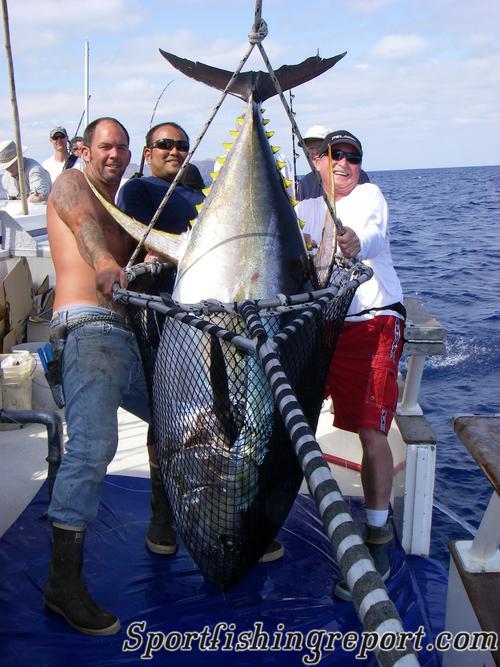
5-11-2009
The San Diego Long Range fleet has had a year like you wouldn't believe, for giant yellowfin of over 300...... Read More
Royal Polaris Gets Seven
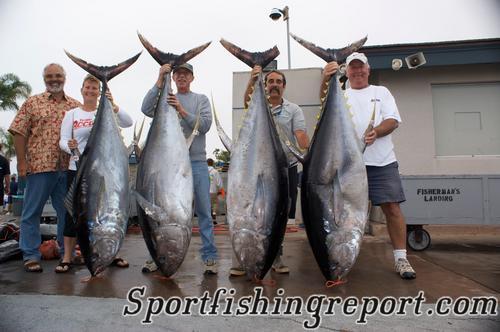
5-10-2009
Roy Rose brought Frank LoPreste's Royal Polaris home May 10 after an 18-day trip with 22 anglers that visited the...... Read More

www.UtahFishReports.com © 2025. All Rights Reserved.
Website Hosting and Design provided by TECK.net
Website Hosting and Design provided by TECK.net

